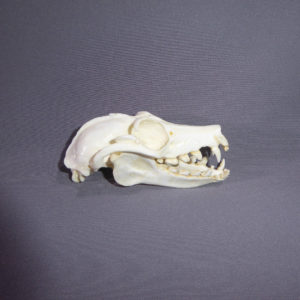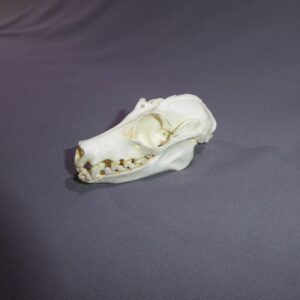Large Fruit Bat Skull Replica measures 3.1 inches. Large Fruit Bat Skull Replica is museum quality polyurethane resin cast. 2-part skull (separate cranium and jaw). Made in USA. Known as the Fruit Bat.
The Large fruit bat, Kalang, or Kalong, is a southeast Asian species of megabat in the family Pteropodidae.
Despite its scientific name, the Large Fruit Bat feeds exclusively on fruits, nectar, and flowers, like the other flying foxes of the genus Pteropus. It is noted for being one of the largest bats.
As with nearly all other Old World fruit bats, it lacks the ability to echolocate but compensates for it with well-developed eyesight.
The Large Fruit Bat is among the largest species of bat. It weighs 1.4 to 2.4 lb. and has a wingspan of up 4 ft 11 inches. Its head-body length is 11 to 13 in. Its forearm length is 7.1 to 8.7 in.
The Large Fruit Bat has a fox-like face. It lacks a tail and has pointed ears. The hairs on much of its body are long and woolly, but are shorter and more erect on the upper back. The mantle hairs tend to be the longest.
The color and texture of the coat differ between sexes and age classes. Males tend to have slightly stiffer and thicker coats than females.
Immature individuals are almost all dull gray-brown. Young have a dark-colored mantle that becomes lighter in males when they mature.
The head has hairs that range in color from mahogany-red and orange-ochreous to blackish. The ventral areas are brown or blackish, tinged with chocolate, gray or silver.
The mantle can vary from pale dirty-buff to orange-yellow, while the chest is usually dark-golden brown or dark russet. The large flying fox has a large and robust skull.
It has a total of 34 teeth. The Large Fruit Bat wings are short and somewhat rounded at the tips. This allows them to fly slowly, but with great maneuverability. The wing membranes are only haired near the body.
This species primarily feeds on flowers, nectar and fruit. When all three food items are available, flowers and nectar are preferred.
The pollen, nectar, and flower of coconut and durian trees, as well as the fruits of rambutan, fig and langsat trees, are consumed. Large Fruit Bats will also eat mangoes and bananas. With fruit, the flying fox prefers the pulp, and slices open the rind to get it.
Colonies of Large Fruit Bats fly in a scattered stream. They may fly up to 31 miles to their feeding grounds in one night. Vocalizations are not made during flight. Large flocks fuse into family or feeding groups upon arrival at feeding grounds.
Large Fruit Bats may circle a fruit tree before landing, and usually land on the tips of branches in an upright position, then fall into a head-down position from which they feed. Feeding aggregations tend to be very noisy.
Female Large Fruit Bat gestations are at their highest between November and January in Peninsular Malaysia, but some births occur in other months.
For the first days, the mothers carry their young, but leave them at the roost when they go on their foraging trips. The young are weaned by two to three months.
The Large Fruit Bat ranges from Malay Peninsula, to the Philippines in the east and Indonesian Archipelago of Sumatra, Java, Borneo and Timor in the south. In certain areas, the bat prefers coastal regions, but it can also be found at elevations up to 4,490 ft.
They inhabit primary forest, mangrove forest, coconut groves, mixed fruit orchards, and a number of other habitats. During the day, trees in mangrove forests and coconut groves may be used as roosts.


